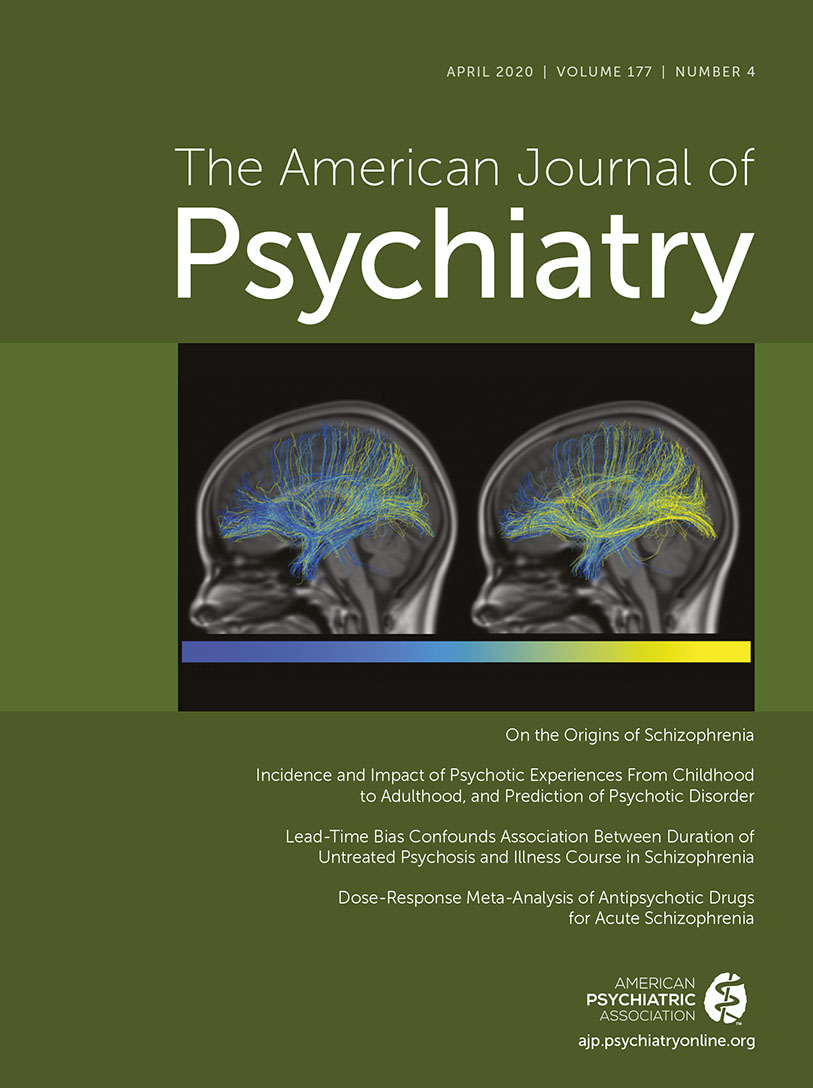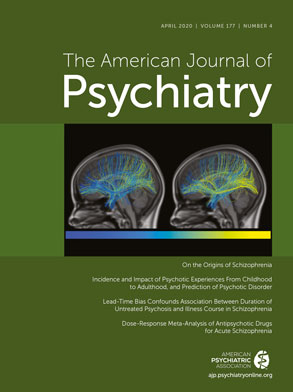Psychotic disorders, especially schizophrenia, can be devastating illnesses, and their estimated prevalence in the United States is around 1%. Schizophrenia—and related illnesses such as schizoaffective disorder—is associated with impairments in psychological and cognitive processes that negatively affect social and occupational functioning and frequently result in marked disability and lifelong suffering. It is estimated that 5% of patients with schizophrenia complete suicide (
1). In addition to suicide, suffering from these illnesses affects general medical health, resulting in lifespans shortened by an estimated 15 to 28 years (
2,
3). Based on twin studies, schizophrenia is estimated to be up to 80% heritable (
4) with very complex underlying genetics (
5). In addition to genetic vulnerabilities, environmental factors are important. Recent research points to gene-by-environment interactions that occur during gestation and early life that may set the stage for the development of alterations in neural structure and function that underlie the pathophysiologies of these disorders (
6).
Although the onset of these illnesses, typically demarcated by a first psychotic episode, is generally in late adolescence or early adulthood, earlier prodromal symptoms, including social withdrawal, psychotic experiences, and cognitive decline, are common. The presence of prodromal symptoms begs the question as to whether we should reconceptualize how we think about the “onset” of schizophrenia. Prodromal symptoms also underscore the importance of understanding phenotypes that place individuals at risk, new approaches to early detection of the illness, and much earlier intervention strategies (
7). This issue of the
Journal addresses these important questions, as it focuses on psychotic disorders with a special emphasis on early symptoms as they relate to risk and on how genetics may influence risk across adolescent development.
As a centerpiece for this issue, Dr. René Kahn, chair of the Department of Psychiatry at the Icahn School of Medicine at Mount Sinai, contributes a thought-provoking overview that emphasizes the importance of cognitive decline prior to a first psychotic episode as being highly relevant to the pathophysiology of schizophrenia (
8). Dr. Kahn’s overview is accompanied by three editorials that highlight important issues raised by the empirical reports that follow. We begin with a research article that addresses how polygenic risk scores (PRSs) can be used to understand different developmental trajectories of risk that relate cognitive decline to schizophrenia. The next two articles explore psychotic experiences occurring during childhood, adolescence, and early adulthood as a risk factor for the later development of psychopathology and in relation to receiving treatment. These articles are then followed by an article pertinent to understanding the potential risk associated with the delayed treatment of schizophrenia. By questioning previous analytic approaches, this article challenges the generally accepted finding that links prolonged duration of pretreatment symptoms to poorer long-term outcomes. The next article presents an intriguing finding that suggests that having an infection is associated with a long-term increase in the risk to develop substance-induced psychosis. Finally, this issue concludes with an article that will be especially useful to practitioners, as it characterizes the doses of specific antipsychotic medications for treating acute psychotic symptoms that will be effective in the greatest number of patients with schizophrenia.
In the first article of this issue, Dickinson and coworkers (
9) used IQs from a large National Institute of Mental Health cohort of patients with schizophrenia to define three different premorbid cognitively related developmental trajectories. The authors then asked whether, and how, the PRSs for schizophrenia, cognition, education attainment, and attention deficit hyperactivity disorder were associated with these different cognitive risk–related trajectories. Their findings demonstrated that the “stable cognitive development trajectory” was associated with less illness severity and that among the four PRSs, only that for schizophrenia was associated with this developmental pattern. The “adolescent cognitive decline trajectory” was associated with the most severe schizophrenia symptoms and poor functional capacity and also was associated with the PRSs for schizophrenia and cognition. Finally, the “preadolescent impairment trajectory” was characterized by childhood learning difficulties, intermediate levels of symptoms, poor educational achievement, and poor employment status. Interestingly, this trajectory was associated with all four of the PRSs that were assessed. In her editorial (
10), Dr. Kathryn Lewandowski, an expert on cognition and psychosis from McLean Hospital and Harvard Medical School, comments on the importance of these new findings for understanding the molecular underpinnings of schizophrenia’s heterogeneity and, importantly, how this relates to different patterns of cognitive development prior to illness onset.
The next article, by Sullivan et al. (
11), focuses on psychotic experiences occurring from childhood to early adulthood as they relate to the development of psychotic disorders. In a sample from the United Kingdom, assessments of psychotic experiences were made from a community cohort of 3,866 individuals at 12, 18, and 24 years of age. Of these participants, 12.7% reported “suspected” or “definite” psychotic experiences, which peaked in incidence between 17 and 19 years of age. When assessed at 24 years of age, 2.8% of the sample met criteria for ever having a psychotic disorder. Although experiencing psychotic symptoms at some point during this period was not a strong predictor of the later development of psychotic disorders, it is noteworthy that approximately one-third of the individuals who had a psychotic experience sought help or reported significantly impaired function. Taken together, these findings put into perspective psychotic experiences as being relatively common and potentially distressing but not as particularly associated with the development of psychotic disorders.
Rimvall et al. in this issue (
12), using a sample of 1,632 children from Copenhagen, also address the implications of childhood psychotic experiences. When screening 11-year-old children, these authors found that 10.5% reported a psychotic experience. Over the next 5 years, children who reported a psychotic experience had an approximate threefold increased risk to receive a psychiatric diagnosis in child and adolescent mental health services. Notably, few of these children who developed psychiatric illnesses developed psychotic disorders; rather, these pediatric patients were found to have a range of disorders across the diagnostic spectrum. In addition, children who at 11 years of age screened positive on a rating scale for a psychiatric illness were found, over the next 5 years, to have a similar risk as the children who reported psychotic experiences. Importantly, by combining the two measures, the predictive value markedly improved, conferring a 7.85-fold increased risk for the later diagnosis of mental health disorders. Dr. Mary Cannon, from the Royal College of Surgeons in Ireland and an expert in understanding risk factors associated with the development of psychiatric disorders, along with a graduate student, Colm Healy, contribute an editorial in which they review these findings and make the strong case for childhood screening coupled with early intervention strategies (
13).
Individuals with psychotic disorders who have a prolonged interval between the onset of their psychotic symptoms and receiving treatment in general have poorer outcomes. It is thought that this could be because these individuals may have a more serious form of the illness and/or that there are neurotoxic effects that occur as a result of untreated illness. In their article, Jonas and coauthors (
14) present data that address the extent to which the association between time to treatment and outcome is a real phenomenon or instead is due to an artifact of analysis termed lead-time bias. Using data from 287 schizophrenia and schizoaffective patients from the Suffolk County Mental Health Project, the authors conclude that prolonged duration to treatment marks early detection of the illness, and when this is taken into account, the illness trajectory of these individuals does not differ from those with a shorter interval between onset of psychosis and treatment. The accompanying editorial by Dr. Donald Goff, a schizophrenia expert from the New York University Grossman School of Medicine, along with Chenxiang Li and Lorna Thorpe (
15), emphasizes previous findings in this domain and the clinical implications of linking prolonged duration to treatment with poorer outcomes. In their editorial, Goff et al. challenge the idea that the relation between prolonged time to treat and worse outcomes can be accounted for by lead-time bias, providing alternative explanations based on the data presented by Jonas et al. (
14).
The final articles in this issue have practical implications for mental health care providers working with patients with psychosis. The first of these, by Hjorthøj and coworkers (
16), links the experience of having an infection with a greater likelihood of later developing a substance-induced psychosis. By studying 3,618 cases of substance-induced psychosis from Danish registers, these investigators found that the presence of any infection increased the risk to develop substance-induced psychosis by twofold over the following 2 years. The authors suggest that this association could be due to infection-induced alterations in immune function, thereby increasing the vulnerability to develop psychosis. However, in the absence of empirical data, alternative explanations for their findings should be considered.
To conclude this issue, the article by Leucht et al. (
17) provides clinically meaningful dosing data for the use of antipsychotic drugs to treat acute symptoms in chronically ill patients with schizophrenia. The meta-analysis the authors perform is aimed at defining the dose of each antipsychotic drug that should be effective in 95% of treated individuals. In addition, the effective dose of each drug was determined in relation to a dose equivalent to 1 mg of risperidone. This is valuable information, but the authors point out limitations that include response differences that are likely to be present in different populations (e.g., older versus younger patients; acute versus chronic patients). Clearly when using these data to guide treatment, dosing decisions should be considered in the context of each patient’s unique and specific characteristics.
In conclusion, this issue of the Journal brings together a collection of papers to inform our readership on risk factors associated with the development of schizophrenia and other psychotic illnesses. The new findings presented here, along with the overview and editorials, demonstrate the complex interactions among the early expression of symptoms, trajectories of cognitive decline, and genetics in determining an individual patient’s illness course. These studies are important, as they provide a step forward in helping conceptualize how we can optimize early intervention strategies for children and adolescents at risk to develop psychotic disorders.

